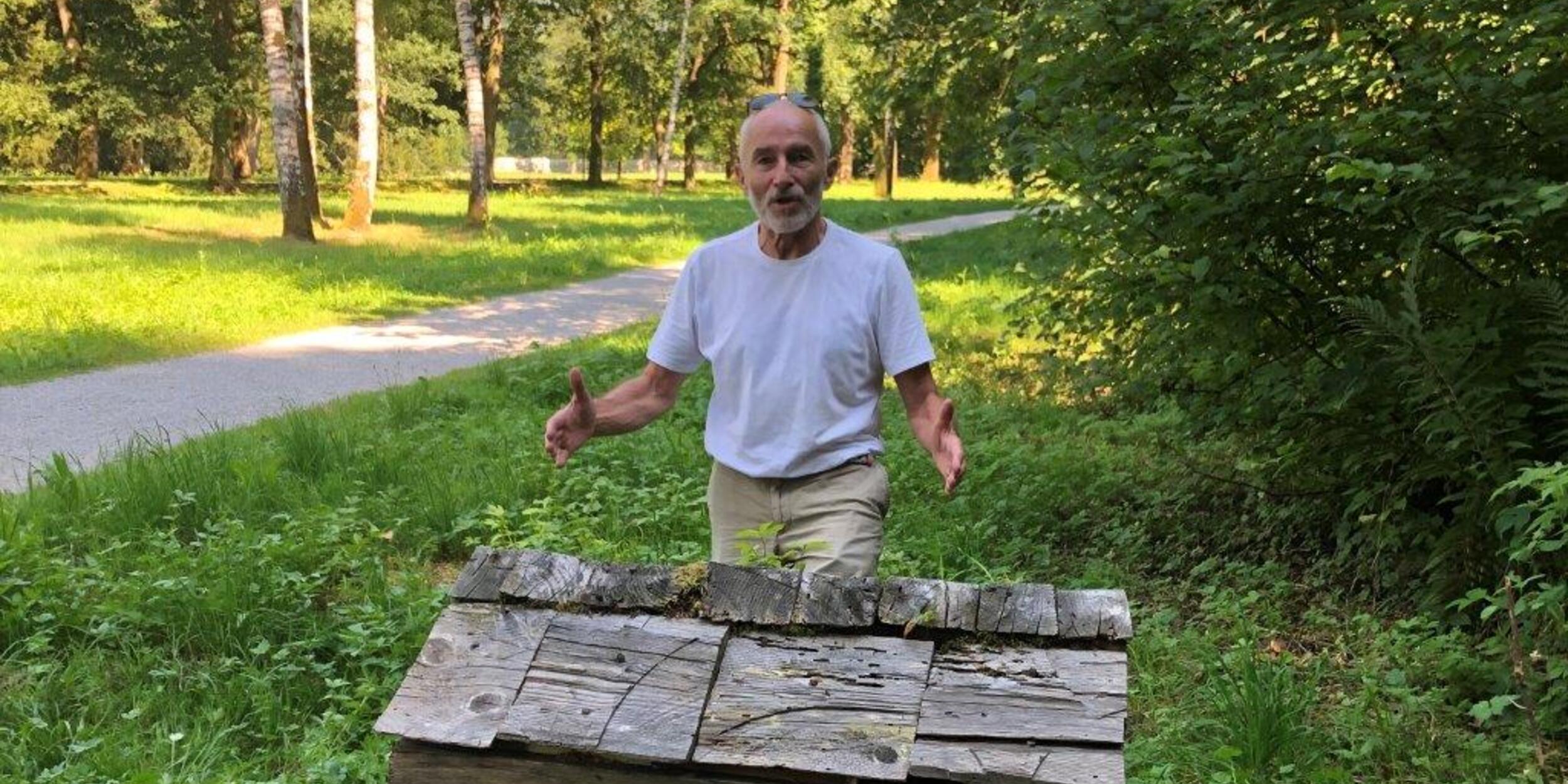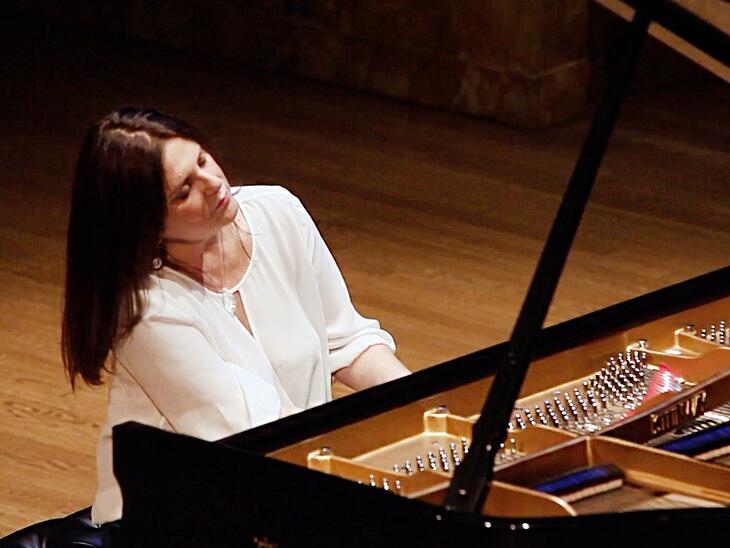Wolfgang Richter worked for 20 years as a freelance journalist (art criticism) for the Salzburger Nachrichten and writes about art and artists. Since the end of the 1990s, he has been realising "land art projects" and is deeply involved with artistic projects in natural spaces.
Your field of activity is very versatile. You work as a visual artist with drawings, etchings, linocuts, ink works, object art, installations, sculptures, furthermore as an educator and as a cultural journalist. How would you describe your daily work?
Admittedly, it was not always easy to combine my activities as an educator and an artist. As an educator, one's schedule is not quite as free and so things simply take longer than if one were "only" working as a freelance artist. That's why I did mostly printmaking while I was teaching. Project work and exhibitions were more difficult to organise, but it worked out in the end. I had already been working for 15 years before I found my passion "nature". At the beginning of my career, I often made the mistake of postponing things I wanted to realise artistically to holidays or to supposedly more suitable times. But that doesn't work. Important things have to be done immediately - also in art! As a didactician, writing about art and artists was and is also a concern of mine. I understand it as a practice-oriented way of teaching. At the moment I'm working on a monograph in which I'm working through my work. It will be about things I have learned with and about nature.
What do you want to convey as an artist? What do you want to endure?
Many viewers of my art tell me that they feel the energy that I have brought to the work. Natural materials exert a special fascination. You can experience and absorb a lot of sensual impressions in nature. Nature means change and the cycle in nature is very exciting: the becoming and passing away, the cycle that determines all our lives. Nature gives us many opportunities for regeneration. The topic has just become very topical due to climate change. We ask ourselves to what extent industrialisation and the actions of humans in the Anthropocene have led to the exploitation of nature. For example, I have been working with the subject of the Untersberg for a very long time (note: current exhibition in the Residenzgalerie) and in this context geology has become important to me. When you deal with rocks, their formation and their change, a very large temporal dimension suddenly opens up. Nature offers me an almost inexhaustible source of topics here, and rocks in particular. The question of where we come from and where we are going takes on a new dimension from this point of view. In the process of erosion, stones change, stones are crushed to sand, are ground smooth. This process of grinding makes time conscious. I want to show the flow and the change, the cycles with my work, because we are part of this cycle. A cultural-historical background is also visible in my work and I notice that this also resonates with the viewers of my work. It is important to me that I use very simple materials such as stones, sand and earth and that I do this against a certain cultural-historical background. You don't have to read very much to experience the sensuality.
In principle, man has been exploiting nature for a very long time. For example, we are damaging forests all over the world and this is also changing our habitat. This continues, of course, with the loss of the moors, the loss of biodiversity, and so on. These themes play into my artistic work, I want people to deal with these issues. With the history of the earth and nature. With the realisation of one's own role in this world, one quickly becomes very humble.
With your work as a freelance artist and art mediator, you have already received prizes. What are the sunny sides and where are the challenges in your profession?
I think it's about the question of meaning. I always deal with things that interest me myself and that are important to me. I think it is very important for educators to do their own research in the disciplines they teach. An excess of theory often leads to students losing the overview and the joy of learning. It is important to try new things and to be allowed to make mistakes so that you can develop further. Teachers who, as practitioners, deal with these issues on a daily basis and struggle to find solutions can convey topics in a completely different way. This approach can be a motor for both pedagogical and artistic work. That's why I believe that someone who studies an artistic-pedagogical subject should also work artistically in that subject so that they can bring the experience into the classroom afterwards.
How important is working with young people for you? What do you want to convey?
I like working with very young people because I have experienced that the younger children are, the more open they are. In order to be able to convey entire workflows and processes, I like to use project work - from the initial idea to implementation. It is important to show that corrective action is also normal. This usually happens too little at school. Pre-set teaching units are often too short to deal with a topic sufficiently. As a teacher, you have to be creative in order to create time and space for this.
What do you think is important for young artists? What should they not be intimidated by? How has your work as an artist and teacher changed over the years?
A lot has changed. When I was a trainee, you were only allowed to exhibit when you had finished your training (laughs). That was certainly not the right strategy. Today, as an artist, you are in the public eye very quickly and you learn a lot - not least from things that didn't work out. The important thing is to keep at it! You have to build up a network, get to know people, exchange ideas with others, learn how things and structures work. Also outside your own institution. You only gain these experiences if you are active and proactive. It is important to dare to go abroad, to look beyond your own borders. The scene in Salzburg is manageable, the possibilities for artistic visibility are better than they used to be, but the response is just that of a medium-sized city. However, the funding measures of the city and the province have been significantly expanded. There are now acquisition programmes, residencies, various prizes - a lot has happened here.
What framework conditions do visual artists need?
A critical and appreciative public that is accompanied by the media.
What is particularly important in art education? How can you get young people excited about art?
The idea that you can only understand art if you have learned a lot about it leads to a dead end. In the beginning, experience is important, it is important to be curious and open. Art appeals to the senses. Every work of art, whether musical or pictorial, is an experience and a stimulus to improve the quality of life. When I have experienced it, then in a second step I am also motivated and want to know more about it. People have the need to design and decorate their spaces. It is about creating an awareness for quality. For this, incentives and offers are needed. You can encourage people to visit studios and reduce their fear of galleries. For starters, you can buy prints cheaply and still have high-quality art that is challenging and enjoyable. Children are much more open-minded when dealing with art. They approach a work more openly and discover a lot as a result. That's why it's important that people can encounter art. This also applies to the spatial experience in the built environment. For this reason, we have developed our own programmes in the association "architektur technik + schule". Here, too, practical experience is important. Knowledge comes afterwards. If there is interest, one automatically acquires knowledge in a field. In school, knowledge is often taught at the wrong time, without personal reference. That is not sustainable. Low-threshold access to art is essential. Art is not a luxury, art is food! Art has to be developed, nurtured and paid for - of course, politics is also called upon here.
Do you notice a shortage of teachers in the arts? And what is the reason for this?
Yes, there is also a shortage of teachers in the arts. The art teachers are not running out of work either. The situation has changed because of the good training centres in Linz and Innsbruck. There are no longer so many reasons to come to Salzburg to complete a teacher training course. There used to be a lot of students from the western provinces but also from Upper Austria in Salzburg. Many of them stayed after graduation. That is no longer the case today. In Linz, great efforts have been made to make the city more attractive, also in the field of art. The competition has become stronger.
What do you need in your job that you didn't learn in your studies?
There is certainly room for improvement in the cooperation with music teachers. This cooperation is still a little lacking and could definitely be started in training. For my exhibitions in the Residenzgalerie, for example, I involved a colleague from the music department with sound installations and music. Music is very important to me in my exhibitions. Not as a "frame", but as part of the artistic expression, an interdisciplinary approach. This approach can be integrated very well into teaching. Pedagogy is not least about showing ways. The curriculum actually leaves a lot of room for manoeuvre. Despite all the debates, we still have a framework curriculum and one can design a great deal. However, you have to learn to use this existing leeway - the sooner, the better! The interplay between the disciplines is tremendous fun!
In addition, cooperation with other institutions is important. For example, museum education. Museums are an important place of learning for practice and therefore internships for students in museums would be very valuable. This way you can get to know institutions with their processes and networks. These are resources that you need as an artist as well as an educator. As a founding member of the Association for Architectural Education - also a part of art education - I have made the experience that in practice, the examination of architecture is often reduced to the study of architectural styles. While this is good to test, it conveys nothing about the value of the built environment. It is equally important to learn how to plan and organise project-oriented lessons, to know the structures that are important for the implementation of projects. You can learn a lot by involving external experts in projects. Whether composers, architects, musicians - they all bring new perspectives and diversity to projects through collaboration. This is how you learn from professional practice. This promotes personal development and can enrich the practice of teaching enormously.






